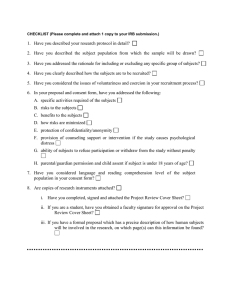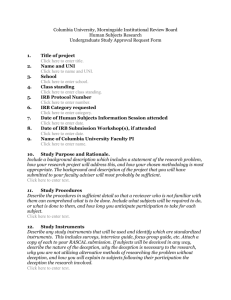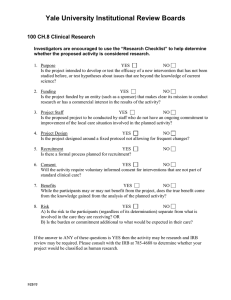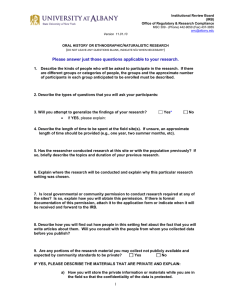How to Answer the Questions Asked in the IRB Application
advertisement
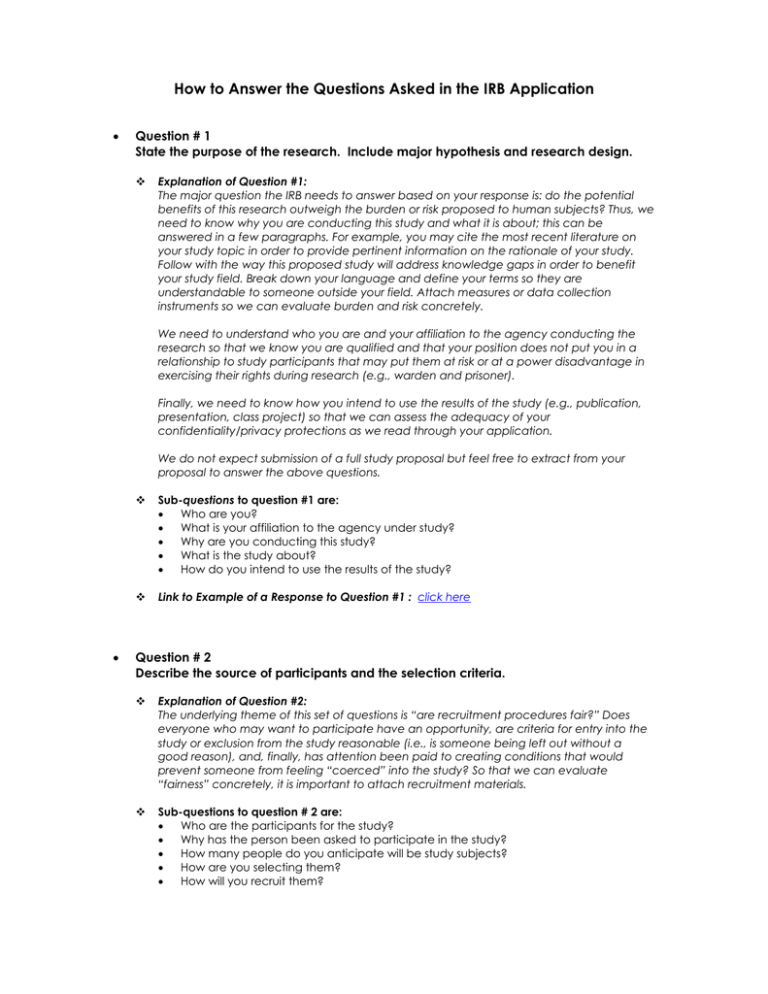
How to Answer the Questions Asked in the IRB Application • Question # 1 State the purpose of the research. Include major hypothesis and research design. Explanation of Question #1: The major question the IRB needs to answer based on your response is: do the potential benefits of this research outweigh the burden or risk proposed to human subjects? Thus, we need to know why you are conducting this study and what it is about; this can be answered in a few paragraphs. For example, you may cite the most recent literature on your study topic in order to provide pertinent information on the rationale of your study. Follow with the way this proposed study will address knowledge gaps in order to benefit your study field. Break down your language and define your terms so they are understandable to someone outside your field. Attach measures or data collection instruments so we can evaluate burden and risk concretely. We need to understand who you are and your affiliation to the agency conducting the research so that we know you are qualified and that your position does not put you in a relationship to study participants that may put them at risk or at a power disadvantage in exercising their rights during research (e.g., warden and prisoner). Finally, we need to know how you intend to use the results of the study (e.g., publication, presentation, class project) so that we can assess the adequacy of your confidentiality/privacy protections as we read through your application. We do not expect submission of a full study proposal but feel free to extract from your proposal to answer the above questions. • Sub-questions to question #1 are: • Who are you? • What is your affiliation to the agency under study? • Why are you conducting this study? • What is the study about? • How do you intend to use the results of the study? Link to Example of a Response to Question #1 : click here Question # 2 Describe the source of participants and the selection criteria. Explanation of Question #2: The underlying theme of this set of questions is “are recruitment procedures fair?” Does everyone who may want to participate have an opportunity, are criteria for entry into the study or exclusion from the study reasonable (i.e., is someone being left out without a good reason), and, finally, has attention been paid to creating conditions that would prevent someone from feeling “coerced” into the study? So that we can evaluate “fairness” concretely, it is important to attach recruitment materials. Sub-questions to question # 2 are: • Who are the participants for the study? • Why has the person been asked to participate in the study? • How many people do you anticipate will be study subjects? • How are you selecting them? • How will you recruit them? • • • What will they be told? If you are in a teacher-student, practitioner-patient, supervisorstaff member please be sure to address the possibility that these relationships may make someone feel they must participate. If you recruit subjects in a group setting please be sure that the participants are fully autonomous to decide whether they want to participate in the study or not. Link to Example of a Response to Question #2 : click here Question # 3 Provide a description of the procedures to be followed. Explanation of Question #3: Provide a detailed description of what the subjects will experience. Describe the setting where the research will take place. If your research is in a group setting please be sure to address the dynamics of the group and the measures taken to protect their confidentiality. If it is an intervention or longitudinal study, please provide information on what procedures you will use to follow the participants. Sub-questions to question # 3 are: • How will participants be involved in the study? • What detailed procedures will be followed? • What intervention or research tools will be used? • Will you follow participants for a longitudinal study? If so, what procedures will be followed? Link to Example of a Response to Question #3 : click here Question # 4 Describe any potential harms and benefits to be derived by subjects with a discussion of the risk/benefit ratio. Explanation of Question # 4: Generally, there are no direct benefits for subjects. There is always the possibility of harm to subjects, even if remote and minor. Risks may include inconvenience, discomfort, embarrassment about revealing personal information, intrusion of privacy, etc. You must sufficiently discuss what these risks may be and propose how you will handle them if they arise. You must also provide a referral list or list of resources if participants experience any potential risks as a result of participating in the study. Sub-questions to question # 4 are: • What are the potential risks to participants? • How will the risks be handled? • Are there any direct benefits? • Have you provided a referral list of list of resource? Link to Example of a Response to Question #4 : click here • Question # 5 Describe the specific methods by which confidentiality and anonymity will be protected. Explanation of Question #5: Make sure you are using the terms anonymity and confidentiality properly. Explain how you intend to keep information confidential. Identify if you can link a subject to data. You must say all study materials will be kept in a locked cabinet in locked offices (specify the location) for a specified period of time. It must be stored for at least three years. It may be necessary to say that all individuals will be disguised in any written reports, particularly if the subject pool is very small. You must address the limits to confidentiality: For data collection that gathers information signaling potential harm to self or others, you must state that if you become “concerned that you are a danger to yourself or others, s/he will alert the proper authorities.” In research that involves parents and children, you are mandated to report any concerns about child abuse or neglect to the proper authorities. For an explanation of the differences between anonymity and confidentiality, please refer to the IRB Alert at http://www.hunter.cuny.edu/irb/pdfs/IRB%20Alert%202.pdf • Sub-questions to question # 5 are: • How will data be stored? • Who has access to the data? • What will happen to the data once the study has been completed? Link to Example of a Response to Question #5 : click here Question # 6 If applicable, provide the following: 1) a description of the debriefing procedures to be used in a cases where deception has occurred; 2) a statement describing what actions you will take should the research reveal the possibility of a medical or other potentially condition. Explanation of Question #6: Deception may be necessary for some studies. Deception is involved when the researcher intentionally does not initially reveal to the participants all details of the study. You must justify why deception is used and participants must be fully informed at the conclusion of the activities. Sub-questions to question # 6 are: • Will the study involve deception? • Have you provided a debriefing script? • Have you detailed when and how participants will be told the full details of the study? • Do participants have the option to withdraw their data if they are bothered by the deception? Link to Example of a Response to Question #6 : click here • • Question # 7 Describe the oral and written consent process and attach all consent documents, including scripts for oral consent and assent form for research involving minors. Explanation of Question #7: Remember that consenting participants is a process and not just a form. Please be sure to details the procedures for obtaining consent/assent. Sub-questions to question # 7 are: • Have you provided consent forms and/or assent forms? • Have you provide a detailed justification if you a requesting a waiver of signature? • Have you detailed to procedures for obtaining consent/assent. Link to Example of a Response to Question #7 : click here Question # 8 You must attach any other information that may be pertinent to the IRB decision. Explanation of Question # 8: If you are conducting or recruiting subjects from an agency, you must obtain permission to do so. Some agencies have their own IRB which you must obtain approval from.
